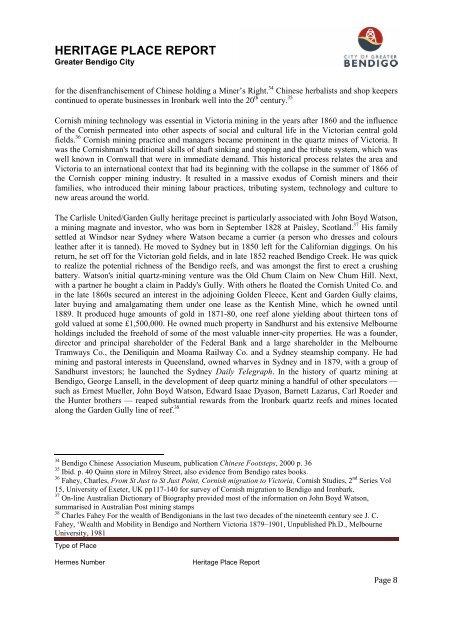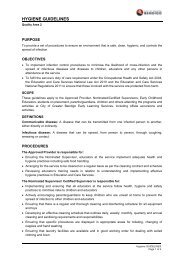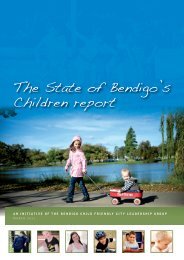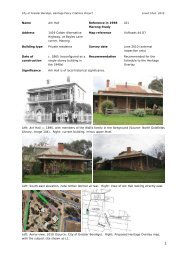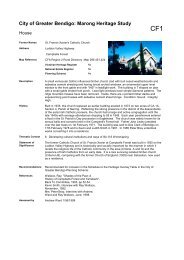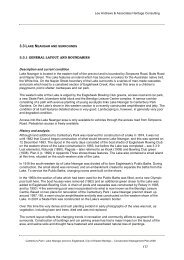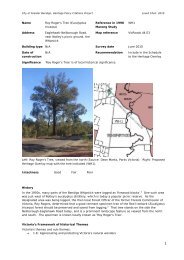HERITAGE PLACE REPORT - City of Greater Bendigo
HERITAGE PLACE REPORT - City of Greater Bendigo
HERITAGE PLACE REPORT - City of Greater Bendigo
You also want an ePaper? Increase the reach of your titles
YUMPU automatically turns print PDFs into web optimized ePapers that Google loves.
<strong>HERITAGE</strong> <strong>PLACE</strong> <strong>REPORT</strong><br />
<strong>Greater</strong> <strong>Bendigo</strong> <strong>City</strong><br />
for the disenfranchisement <strong>of</strong> Chinese holding a Miner’s Right. 34 Chinese herbalists and shop keepers<br />
continued to operate businesses in Ironbark well into the 20 th century. 35<br />
Cornish mining technology was essential in Victoria mining in the years after 1860 and the influence<br />
<strong>of</strong> the Cornish permeated into other aspects <strong>of</strong> social and cultural life in the Victorian central gold<br />
fields. 36 Cornish mining practice and managers became prominent in the quartz mines <strong>of</strong> Victoria. It<br />
was the Cornishman's traditional skills <strong>of</strong> shaft sinking and stoping and the tribute system, which was<br />
well known in Cornwall that were in immediate demand. This historical process relates the area and<br />
Victoria to an international context that had its beginning with the collapse in the summer <strong>of</strong> 1866 <strong>of</strong><br />
the Cornish copper mining industry. It resulted in a massive exodus <strong>of</strong> Cornish miners and their<br />
families, who introduced their mining labour practices, tributing system, technology and culture to<br />
new areas around the world.<br />
The Carlisle United/Garden Gully heritage precinct is particularly associated with John Boyd Watson,<br />
a mining magnate and investor, who was born in September 1828 at Paisley, Scotland. 37 His family<br />
settled at Windsor near Sydney where Watson became a currier (a person who dresses and colours<br />
leather after it is tanned). He moved to Sydney but in 1850 left for the Californian diggings. On his<br />
return, he set <strong>of</strong>f for the Victorian gold fields, and in late 1852 reached <strong>Bendigo</strong> Creek. He was quick<br />
to realize the potential richness <strong>of</strong> the <strong>Bendigo</strong> reefs, and was amongst the first to erect a crushing<br />
battery. Watson's initial quartz-mining venture was the Old Chum Claim on New Chum Hill. Next,<br />
with a partner he bought a claim in Paddy's Gully. With others he floated the Cornish United Co. and<br />
in the late 1860s secured an interest in the adjoining Golden Fleece, Kent and Garden Gully claims,<br />
later buying and amalgamating them under one lease as the Kentish Mine, which he owned until<br />
1889. It produced huge amounts <strong>of</strong> gold in 1871-80, one reef alone yielding about thirteen tons <strong>of</strong><br />
gold valued at some £1,500,000. He owned much property in Sandhurst and his extensive Melbourne<br />
holdings included the freehold <strong>of</strong> some <strong>of</strong> the most valuable inner-city properties. He was a founder,<br />
director and principal shareholder <strong>of</strong> the Federal Bank and a large shareholder in the Melbourne<br />
Tramways Co., the Deniliquin and Moama Railway Co. and a Sydney steamship company. He had<br />
mining and pastoral interests in Queensland, owned wharves in Sydney and in 1879, with a group <strong>of</strong><br />
Sandhurst investors; he launched the Sydney Daily Telegraph. In the history <strong>of</strong> quartz mining at<br />
<strong>Bendigo</strong>, George Lansell, in the development <strong>of</strong> deep quartz mining a handful <strong>of</strong> other speculators —<br />
such as Ernest Mueller, John Boyd Watson, Edward Isaac Dyason, Barnett Lazarus, Carl Roeder and<br />
the Hunter brothers — reaped substantial rewards from the Ironbark quartz reefs and mines located<br />
along the Garden Gully line <strong>of</strong> reef. 38<br />
34<br />
<strong>Bendigo</strong> Chinese Association Museum, publication Chinese Footsteps, 2000 p. 36<br />
35<br />
Ibid. p. 40 Quinn store in Milroy Street, also evidence from <strong>Bendigo</strong> rates books.<br />
36 nd<br />
Fahey, Charles, From St Just to St Just Point, Cornish migration to Victoria, Cornish Studies, 2 Series Vol<br />
15, University <strong>of</strong> Exeter, UK pp117-140 for survey <strong>of</strong> Cornish migration to <strong>Bendigo</strong> and Ironbark.<br />
37<br />
On-line Australian Dictionary <strong>of</strong> Biography provided most <strong>of</strong> the information on John Boyd Watson,<br />
summarised in Australian Post mining stamps<br />
38<br />
Charles Fahey For the wealth <strong>of</strong> <strong>Bendigo</strong>nians in the last two decades <strong>of</strong> the nineteenth century see J. C.<br />
Fahey, ‘Wealth and Mobility in <strong>Bendigo</strong> and Northern Victoria 1879–1901, Unpublished Ph.D., Melbourne<br />
University, 1981<br />
Type <strong>of</strong> Place<br />
Hermes Number Heritage Place Report<br />
Page 8


